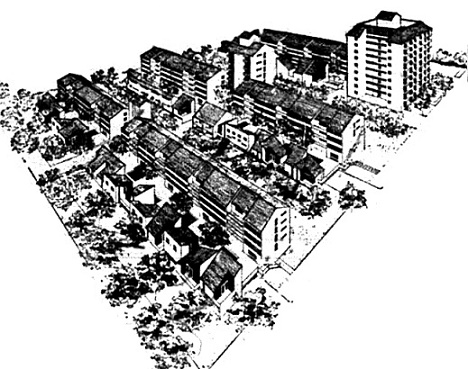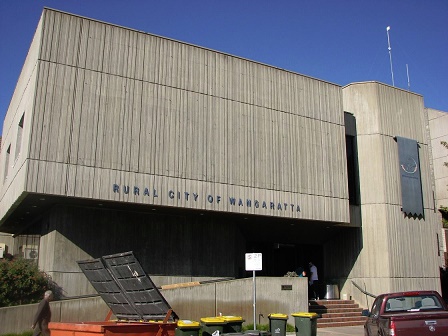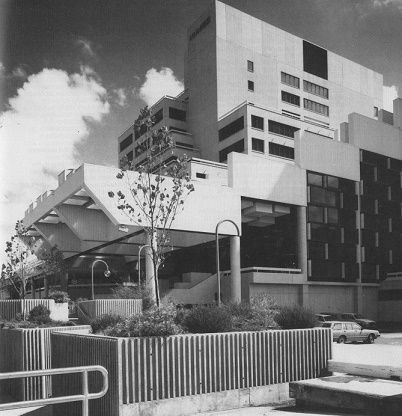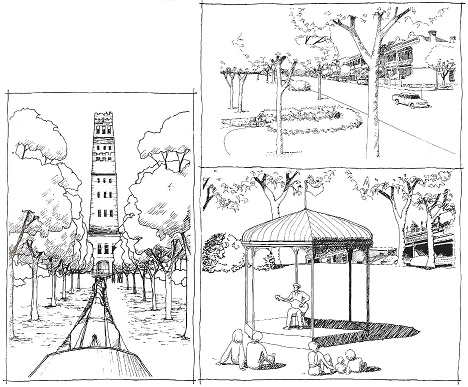The
son of a nurseryman from Geelong, Grahame Richard John Shaw commenced
his architectural studies at Gordon Institute of Technology
and later transferred to the University of Melbourne's Architectural
Atelier, where he studied from 1948 to 1950. By the time he
became registered as an architect in July 1951, he was employed in the
Department of Works & Housing at 225 Bourke Street. The
next year, he departed for overseas experience, arriving in
England in September 1952. There, he obtained work in the
London office of Riches & Blythin, which had previously employed several
other visiting Australians, notably Leslie Perrott and Stuart Warmington.
In 1954, Shaw returned to Melbourne and resumed his position with the Department of Works. Later that decade, he transferred thence to the Housing Commission of Victoria, where he was engaged (along with the commission's 'Slum Research Officer', J H Davey) on a comprehensive project to identify inner suburban areas for potential slum reclamation. Published in 1960, this survey (known as the Shaw-Davey Report) drew attention to almost 1,000 acres said to require "immediate attention" in the municipalities of North Melbourne, Carlton, Fitzroy, Collingwood, Richmond, Prahran, South Melbourne and Port Melbourne. Also in 1960, Shaw was promoted to the position of Chief Deisgn Architect, elected an associate of the RAIA and completed a Diploma of Town & Regional Planning at the University of Melbourne. He went on to undertake further study in that field, and, in 1963, become the first recipient of a new degree, the Bachelor of Town & Regional Planning.
In 1967, while still employed with the Housing Commission, Shaw became involved in the preparation of a planning scheme for the City of Footscray, in conjunction with architects Earle & Partners. At the conclusion of the project, he accepted James Earle's offer to join the firm permanently. Earle's practice, founded in 1954, was then best known as designers of single residences and ecclesiastical buildings. With his expertise in town planning and landscape architecture, Shaw steered the firm's subsequent output in a wholly new direction, introducing larger-scaled multi-dwelling projects such as the Cross Street townhouses in Carlton (1970-71), which was Melbourne's first co-operative housing development.
In August 1972, Shaw left Earle's office to estalbish his own practice with two younger fellow staff members, John Denton and Bill Corker. The new partnership, styled as Shaw, Denton & Corker, promptly expanded with the admission of two more partners: architect Barrie Marshall (who had then recently returned from overseas) and landscape architect Andras Kelly. Over the next few years, the office was principally involved in town planning, urban design and landscaping projects, and undertook only a few small-scaled architectural commissions. In 1976, Grahame Shaw and Andras Kelly both departed, whereupon the three remaining directors established the award-winning and eduring practice of Denton Corker Marshall (DCM).
Meanwhile, Shaw re-established sole practice as Grahame Shaw & Partners, which was further reconfigured as a limited liability company in 1977. Over the next few years, the office landed a few high-profile commissions, notably the World Trade Centre on the north bank of the Yarra River, and also had success in several design competitions. In 1977, they won first prize in a competition sponsored by the RAIA Housing Service, and a prototype of their winning design was built in Endeavour Hills. In 1984, the office was one of three finalists in an MCC competition for a landscaping masterplan at Royal Park. Shaw's Victorian-themed entry, which was to incorporate a visitors' centre, a statue of the Burke & Wills party and replica of Coop's Shot Tower, was published in Landscape Australia journal in Spring 1985. Sadly, this coincided with Grahame Shaw's premature death on 10 September, aged only 57 years. His company, Grahame Shaw & Partners Pty Ltd, was formally deregistered in early 1992.
In 1954, Shaw returned to Melbourne and resumed his position with the Department of Works. Later that decade, he transferred thence to the Housing Commission of Victoria, where he was engaged (along with the commission's 'Slum Research Officer', J H Davey) on a comprehensive project to identify inner suburban areas for potential slum reclamation. Published in 1960, this survey (known as the Shaw-Davey Report) drew attention to almost 1,000 acres said to require "immediate attention" in the municipalities of North Melbourne, Carlton, Fitzroy, Collingwood, Richmond, Prahran, South Melbourne and Port Melbourne. Also in 1960, Shaw was promoted to the position of Chief Deisgn Architect, elected an associate of the RAIA and completed a Diploma of Town & Regional Planning at the University of Melbourne. He went on to undertake further study in that field, and, in 1963, become the first recipient of a new degree, the Bachelor of Town & Regional Planning.
In 1967, while still employed with the Housing Commission, Shaw became involved in the preparation of a planning scheme for the City of Footscray, in conjunction with architects Earle & Partners. At the conclusion of the project, he accepted James Earle's offer to join the firm permanently. Earle's practice, founded in 1954, was then best known as designers of single residences and ecclesiastical buildings. With his expertise in town planning and landscape architecture, Shaw steered the firm's subsequent output in a wholly new direction, introducing larger-scaled multi-dwelling projects such as the Cross Street townhouses in Carlton (1970-71), which was Melbourne's first co-operative housing development.
In August 1972, Shaw left Earle's office to estalbish his own practice with two younger fellow staff members, John Denton and Bill Corker. The new partnership, styled as Shaw, Denton & Corker, promptly expanded with the admission of two more partners: architect Barrie Marshall (who had then recently returned from overseas) and landscape architect Andras Kelly. Over the next few years, the office was principally involved in town planning, urban design and landscaping projects, and undertook only a few small-scaled architectural commissions. In 1976, Grahame Shaw and Andras Kelly both departed, whereupon the three remaining directors established the award-winning and eduring practice of Denton Corker Marshall (DCM).
Meanwhile, Shaw re-established sole practice as Grahame Shaw & Partners, which was further reconfigured as a limited liability company in 1977. Over the next few years, the office landed a few high-profile commissions, notably the World Trade Centre on the north bank of the Yarra River, and also had success in several design competitions. In 1977, they won first prize in a competition sponsored by the RAIA Housing Service, and a prototype of their winning design was built in Endeavour Hills. In 1984, the office was one of three finalists in an MCC competition for a landscaping masterplan at Royal Park. Shaw's Victorian-themed entry, which was to incorporate a visitors' centre, a statue of the Burke & Wills party and replica of Coop's Shot Tower, was published in Landscape Australia journal in Spring 1985. Sadly, this coincided with Grahame Shaw's premature death on 10 September, aged only 57 years. His company, Grahame Shaw & Partners Pty Ltd, was formally deregistered in early 1992.
Select List of Projects
Housing Commisison of Victoria (Chief Design Architect, 1960-67)
| 1964 | Public housing development, Cole Street, Laverton North |
Earle, Shaw & Partners (1967-72)
| 1967 1969 1971 | Yarra River landscaping scheme for City of Heidelberg Residence for self, Heidelberg St Nektarios Greek Orthodox Church, Fawkner Co-operative townhouse development, Cross Street, Carlton |
Shaw, Denton & Corker (1972-76)
| 1975 | Heyington Railway Station, Toorak (competition entry) |
Grahame Shaw & Partners (Pty Ltd) (1976-1992)
| 1976 1977 1979 1981 1984 | Wangaratta Centre for the Arts, Ovens Street, Wangaratta (Stage 1) House (V3202) for RAIA Housing Service, Endeavour Hills Wangaratta Centre for the Arts, Ovens Street, Wangaratta (Stage 2) World Trade Centre, Spencer Street, Melbourne Landscaping masterplan for Royal Park (competition entry) |
top
 | |
| Co-operative housing development, Cross Street, Carlton (Earle, Shaw & Partners, 1969-71) |
 | |
| Wangaratta Centre for the Arts, Ovens Street, Wangaratta (Grahame Shaw & Partners, 1976-77; 1979-80) (Photography by Simon Reeves, Built Heritage Pty Ltd) |
 | |
| World Trade Centre (Grahame Shaw & Partners, 1979-81) (photograph by John Gollings) |
 | |
| Sketches for Royal Park landscape masterplan (1984-85) |
